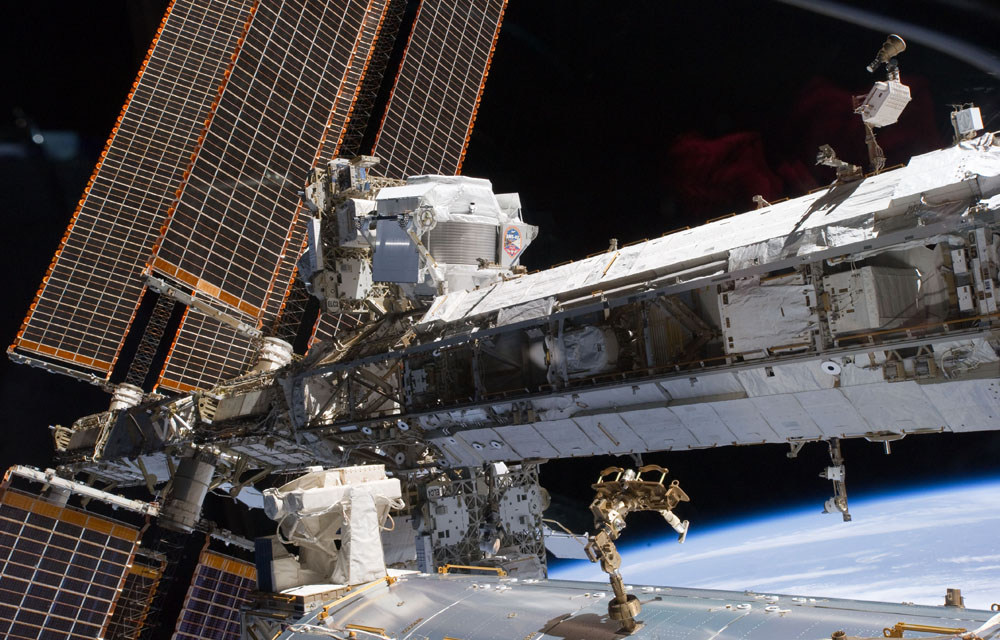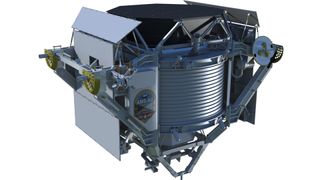NASA to Announce Major Astrophysics Discovery Today

UPDATE for 11 a.m. ET: The first official announcements for today's news have been released. See the latest story here: Dark Matter Possibly Found by $2 Billion Space Station Experiment.
NASA will unveil the first discoveries from a powerful $2 billion particle physics experiment on the International Space Station in what could be a major vindication for the science tool, which almost never made it into space.
The space agency will hold a press conference at 1:30 p.m. EDT (1830 GMT) today, April 3, to reveal the first science results from the experiment, called the Alpha Magnetic Spectrometer. You can watch the AMS science results live on SPACE.com, via NASA TV.
The Alpha Magnetic Spectrometer is an advanced cosmic-ray detector designed to seek out signs of antimatter and elusive dark matter from its perch on the backbone-like main truss of the International Space Station. More than 200 scientists representing 16 countries and 56 institutions are part of the science team, which is led by Nobel laureate Samuel Ting, a physicist at MIT.
"AMS is a state-of-the-art cosmic ray particle physics detector located on the exterior of the International Space Station," NASA officials said in an announcement Tuesday (April 2). [See photos of the Alpha Magnetic Spectrometer in space]
NASA and the AMS team have not revealed exactly what the first science results from AMS will be, but Ting has assured that it will be a significant announcement.
"It will not be a minor paper," Ting said on Feb. 17 during the annual meeting of the American Association for the Advancement of Science in Boston, adding that it would represent a "small step" toward understanding the true nature of dark matter, even if it is not the final answer.
Get the Space.com Newsletter
Breaking space news, the latest updates on rocket launches, skywatching events and more!
The spectrometer consists of a huge, 3-foot wide magnet that bends the paths of cosmic particles and steers them into special detectors designed to measure particles' charge, energy and other properties. The complicated space experiment was 16 years in the making, but despite its lofty mission, the 7-ton AMS almost never flew.
In fact, NASA canceled the space shuttle mission originally slated to launch AMS to the space station in 2005. At the time, the space agency cited safety concerns following the 2003 space shuttle Columbia accident – an event that led directly to the space shuttle fleet's retirement in 2011.
But NASA's decision to cancel the AMS mission did not sit well with the science community. Scientists launched a persistent campaign to resurrect the AMS launch, including an intense lobbying effort to sway lawmakers in Congress to their side.
The fight back was a success. Congress approved funding for an extra space shuttle mission that would launch the AMS experiment to the space station. That mission, NASA's STS-134 flight aboard Endeavour, launched into space in May 2011.
"I never had any doubt when they were going to fly. I think it was three days after the inauguration of President Obama, we were on the manifest," Ting told SPACE.com in 2011, just before the experiment arrived at the station. "We didn't change the mission, we just continued."

During the fight to revive the AMS experiment, NASA and its International Space Station partners also approved a plan to extend the orbiting laboratory's operations in space through 2020. That decision prompted Ting and his science team to make a last-minute change to the AMS instrument. The team swapped out the spectrometer's original magnet, which would last only a few years, for a longer-lasting permanent magnet to allow for longer science observations.
The Alpha Magnetic Spectrometer was first attached to the International Space Station on May 16, 2011. Three days later, the instrument was activated for the first time and has been performing science observations ever since. The instrument is managed by NASA's Johnson Space Center in Houston, which is home to the space station's Mission Control.
Visit SPACE.com today for complete coverage of NASA's Alpha Magnetic Spectrometer announcements.
Email Tariq Malik at tmalik@space.com or follow him @tariqjmalikand Google+. Follow us @Spacedotcom, Facebookand Google+. Original article on SPACE.com.
Join our Space Forums to keep talking space on the latest missions, night sky and more! And if you have a news tip, correction or comment, let us know at: community@space.com.

Tariq is the Editor-in-Chief of Space.com and joined the team in 2001, first as an intern and staff writer, and later as an editor. He covers human spaceflight, exploration and space science, as well as skywatching and entertainment. He became Space.com's Managing Editor in 2009 and Editor-in-Chief in 2019. Before joining Space.com, Tariq was a staff reporter for The Los Angeles Times covering education and city beats in La Habra, Fullerton and Huntington Beach. In October 2022, Tariq received the Harry Kolcum Award for excellence in space reporting from the National Space Club Florida Committee. He is also an Eagle Scout (yes, he has the Space Exploration merit badge) and went to Space Camp four times as a kid and a fifth time as an adult. He has journalism degrees from the University of Southern California and New York University. You can find Tariq at Space.com and as the co-host to the This Week In Space podcast with space historian Rod Pyle on the TWiT network. To see his latest project, you can follow Tariq on Twitter @tariqjmalik.